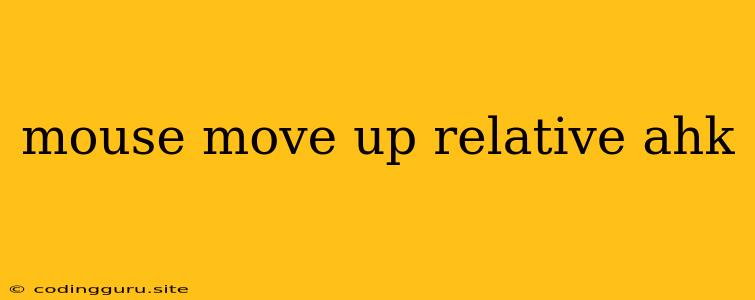Mouse Move Up Relative: A Comprehensive Guide to AutoHotkey Scripting
AutoHotkey is a powerful scripting language that can automate tasks on your computer, and a common task is to move the mouse. But what about moving the mouse relatively? This guide will explore the fundamentals of using the "MouseMove" command in AutoHotkey, focusing specifically on how to move the mouse up relative to its current position.
Understanding the Basics of MouseMove
The "MouseMove" command is the heart of mouse control in AutoHotkey. It takes two parameters: the horizontal and vertical distance to move the mouse cursor. Let's break it down:
MouseMove, X, Y
- X: This determines how many pixels the mouse moves horizontally. A positive value moves the mouse to the right, while a negative value moves it to the left.
- Y: This determines how many pixels the mouse moves vertically. A positive value moves the mouse down, while a negative value moves it up.
The Key to Relative Movement: "Relative" Parameter
To make the mouse move relative to its current position, you need to add the "Relative" parameter to the "MouseMove" command. This makes all the difference:
MouseMove, X, Y, Relative
By using "Relative", the mouse will move by the specified X and Y values from its current position.
Moving the Mouse Up: The "Y" Parameter
Now, to move the mouse up, you need to make the Y parameter negative. For example:
MouseMove, 0, -100, Relative
This script will move the mouse cursor 100 pixels up from its current location.
Combining Relative Movement and Other Scripts
The power of AutoHotkey lies in its flexibility. You can easily combine relative mouse movement with other scripts to create complex and useful automation tasks:
-
Scroll Up:
MouseMove, 0, -10, Relative SendInput {WheelUp}This script will move the mouse up 10 pixels and then send a "WheelUp" command, simulating scrolling up with your mouse wheel.
-
Continuous Upward Movement:
Loop { MouseMove, 0, -1, Relative Sleep, 10 }This script will move the mouse up by 1 pixel every 10 milliseconds, creating a smooth upward movement that you can stop by pressing "Escape".
-
Clicking after Movement:
MouseMove, 0, -50, Relative ClickThis script will move the mouse 50 pixels up and then click the left mouse button at the new position.
Practical Examples: Make Mouse Movement Easier
Here are some real-world scenarios where using the "MouseMove" command with the "Relative" parameter is incredibly helpful:
-
Navigating Long Documents: You can create a script to move the mouse up by a fixed amount with each key press, allowing you to quickly navigate long documents or web pages.
-
Fine-Tuning Cursor Placement: Instead of clicking and dragging, you can use relative movement to precisely position the cursor over a specific element.
-
Automating Repetitive Tasks: You can use relative movement to create scripts for repeating tasks, such as moving the mouse to a specific button in a program and clicking it.
Important Notes:
- Speed: The "MouseMove" command can have a variable speed depending on your computer's performance and the distance being moved.
- Windows Restrictions: Some programs may have limitations on how fast you can move the mouse. You might need to adjust the script's parameters to avoid errors or unwanted behavior.
- Testing is Key: Always test your scripts before using them in a critical scenario. Make sure the mouse movement is exactly what you expect.
Conclusion
The "MouseMove" command with the "Relative" parameter provides a powerful way to control the mouse cursor in AutoHotkey. Understanding how to use relative movement for tasks like moving the mouse up opens up a wide range of automation possibilities. With a little practice, you can create efficient and useful scripts that improve your workflow and simplify your computer interactions.
